
ROCK SOUP AND MESQUITE MUSHROOMS

Maru Toledo and Godo Oseguera are co-directors of the Research Center for the Rescue of the Oral Tradition and Gastronomy of the Valles Region of Jalisco. They teach colonial and prehispanic cooking in the shadow of the Guachimontón pyramids of Teuchitlán.
|
Upon our arrival, we were handed a glass of grenadine punch. “This is not prehispanic,” said Maru, “but it’s something I’m very proud of. The secret of making it has been in my family for generations.” When she began to describe the difficult process of squeezing the juice from pomegranate seeds, we suspected we were in for a treat and, in fact, one sip convinced us that Maru’s punch was a thousand times better than the very best ponche you’ll ever find in the Sierra de Tapalpa.
|
 |
Before the cooking began in earnest, Godo had us line up for a traditional Dance of Joy which included giving thanks to the four cardinal directions for all the good things that come to us from each of them, followed by loud blasts on a conch shell trumpet and formation of a conga line that snaked all around the property.
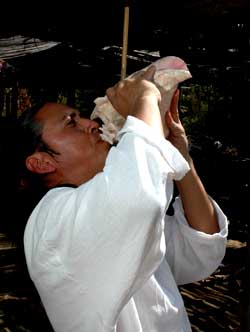 
Left: Godofredo Oseguera on the conch trumpet.
Right: First dance, then eat. |
After the ceremony, Maru announced that our meal would begin with “Stone Soup.” The ingredients for the soup were shrimp, both dried and fresh, onions, chiles, epazote (wormseed), cherry tomatoes and jaltomates, Mexico’s tiny but strongly flavored natural tomato, which happens to be the granddaddy of all the hybrid tomatoes on the planet. These ingredients were mixed into cold water inside a bule, a large bowl made from a gourd. Godo then removed a red-hot basalt rock from the fire and dropped it into the bowl. Instantly, the water was steaming and hissing and the soup was cooking.
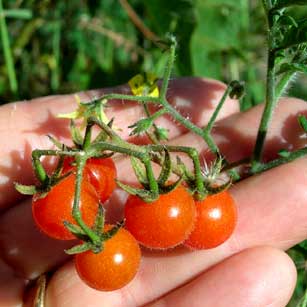 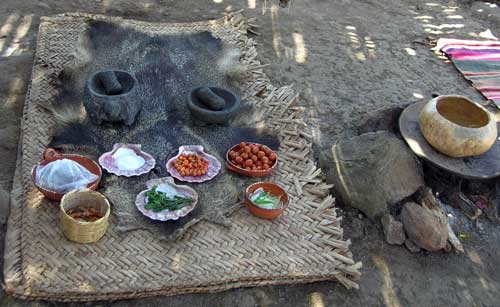 Left:
jaltomates still grow wild in the Primavera Forest. Unlike the seeds of
store-bought tomatoes, these will sprout. Left:
jaltomates still grow wild in the Primavera Forest. Unlike the seeds of
store-bought tomatoes, these will sprout.Right: The ingredients for Stone Soup. The gourd bowl is on the far right. |
|
As soon as the sizzling hot basalt rock was dropped into the gourd bowl, the soup started boiling.
|
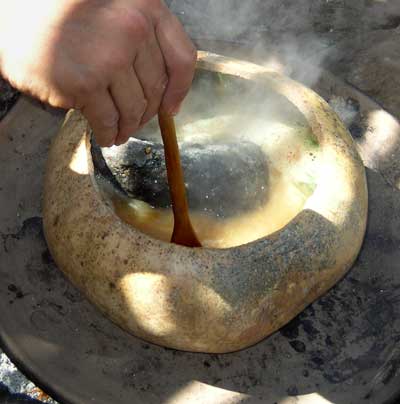 |
As the rock soup bubbled, we watched the even more curious procedure for cooking the main dish, mesquite mushrooms. The ingredients were few: mushrooms, a small amount of chile cora, a little salt and some mesquite pods. The mushroom mix was placed upon a banana leaf (hoja de vástago) nearly a meter long and wrapped up to form a package about the size of a small loaf of bread, which was then tied up with tough agave fibers.
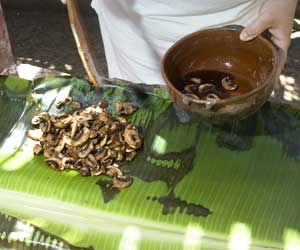  Left:
the ingredients for the Mesquite Mushrooms are placed on a large banana
leaf Left:
the ingredients for the Mesquite Mushrooms are placed on a large banana
leaf
Right: The "package" is tied. |
| Next came a curious step. Godo placed the
“package” next to a large lump of nearly black mud. This, he told us, was clay
from nearby San Marcos, a little town famous for its pottery. Carefully, Godo
coated every side of the green bundle with a layer of clay about 3
centimeters thick until it looked exactly like a loaf of German black bread...
|
 |
...He now rubbed ashes all over the outside of it and then buried it in the campfire, under hot coals. “not just any mud will do,” said Godo, rolling a long clay “cigar” which he then picked up by one end. “If it doesn’t break when you hold it like this, then you’ve got the right clay for the job.”
|
The baking of the mushrooms took only half an hour. Godo then used a shovel to retrieve them from the fire.
|
 |
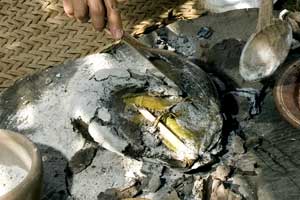  Left:
The now hard clay "package" is broken open and a delightful aroma
reaches our noses Left:
The now hard clay "package" is broken open and a delightful aroma
reaches our nosesRight: With a sliver of obsidian, Godo cuts open the banana-leaf wrapping. |
While the mushrooms were baking, our hosts prepared “original” tortillas for us, the kind that—according to archeologists—were commonly eaten by indigenous people in this area and as far south as Colombia and Peru.
Today’s tortillas are made from grains of corn whose hull has been removed by overnight soaking in lime water. This process is called nixtamalización, a word that comes from Nahuatl “nextli” (ashes) and “tamalli” (corn dough). According to Maru, saltpeter or the ashes of burnt seashells were originally used for the job, rather than lime.
In Western Mexico, however, tortillas were made from unprocessed grains of corn mixed fifty-fifty with amaranth, which is said to be extremely healthy. It seems amaranth seeds contain a complete set of amino acids and also reduce hypertension, blood pressure and cholesterol levels.
|
We watched Godo grind the corn and amaranth into a fine powder in a huilanche, which is a metate with no legs...
|
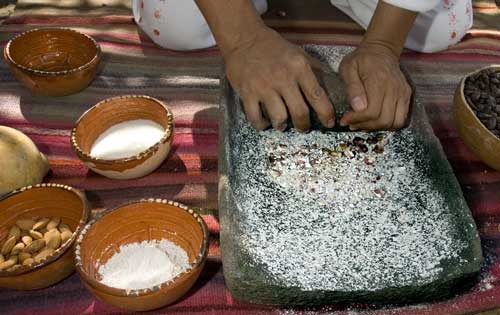 |
...Maru and her helper Francisca Flores added water to the powder and patted the dough into tortillas much thicker than the ones we’re used to today. These were then placed at the edge of the fire for a little while, where they expanded slightly. We then spread a little salsa on our original tortillas and gobbled them down. The amaranth-corn combination tastes good, but not at all like the tortillas Mexicans are used to today. Like many foods which are good for you, this one will probably never catch on in the modern world.
 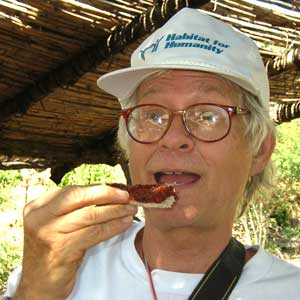 Left:
Amaranth-corn tortillas, ready to eat. They're just a bit different from
the traditional kind Left:
Amaranth-corn tortillas, ready to eat. They're just a bit different from
the traditional kind
Right: John Pint ready to take his first bite of a "real" tortilla. |
The stone soup and mesquite mushrooms, however, would win prizes in any culinary competition, a sentiment shared by Enrique Meza Rosales, Presidente Municipal of Teuchitlán, who joined us for the sumptuous feast that followed all the cooking.
Our hosts also prepared tamales the old-fashion (Maya) way inside a large pot whose lid was sealed with dough. These tamales were tastily flavored with quelite or amaranth greens, also known as Chinese Spinach, even though it was cultivated as a food crop here in Mexico some 7000 years ago. Once again those ancient Mexicans seem ‘way ahead of us moderns in nutritional knowledge. We discovered that amaranth greens are a very good source of vitamin A, B6, C, riboflavin, iron, calcium, magnesium, phosphorus, potassium, copper, zinc and manganese. Popeye would have loved these tamales!
Those of us with foresight saved a little room for dessert. This was yet another prehispanic delight, a northern Jalisco specialty known as coscoatl.
| Maru Toledo mixes the ingredients for the coscoatl dessert. Her eyes seem to say: "You won't be able to resist this."
Ground peanuts
|
 |
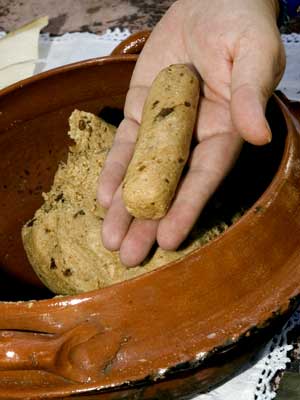 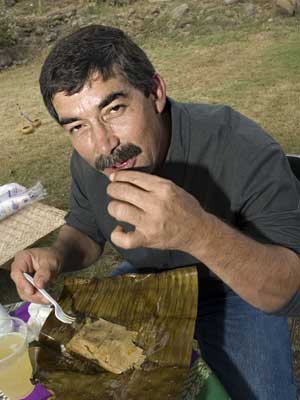
Left: a coscoatl ready to be wrapped in a corn husk and steamed.
Right: Enrique Meza Rosales, the President of Teuchitlán, enjoying a healthy quelite (amaranth leaf) tamal. |
| The dessert and everything else was washed down with a mixture of aguamiel (sweet juice from the heart of a living maguey root) and pineapple juice. Yes, pineapples, too, originated on this side of the Atlantic and were probably introduced to Europe by Christopher Columbus.
|
 |
Well, by the end of the day, we were stuffed, but amazingly, we still felt light. No doubt this was due to the fact that neither grease, nor oil, nor fat were used to prepare any part of our tasty and memorable meal. Our hats are off to Maru Toledo and Godo Oseguera for their admirable project to rescue these cooking traditions of yesteryear and we also thank the Wixarica (Huichol) people who have passed along their culinary knowledge and techniques to these gastronomic pioneers.
John and Susy Pint
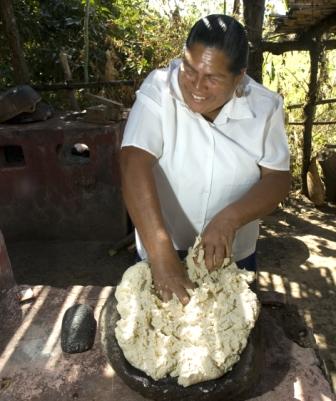 |
Francisca Flores puts heart, soul and muscle into making tortillas.